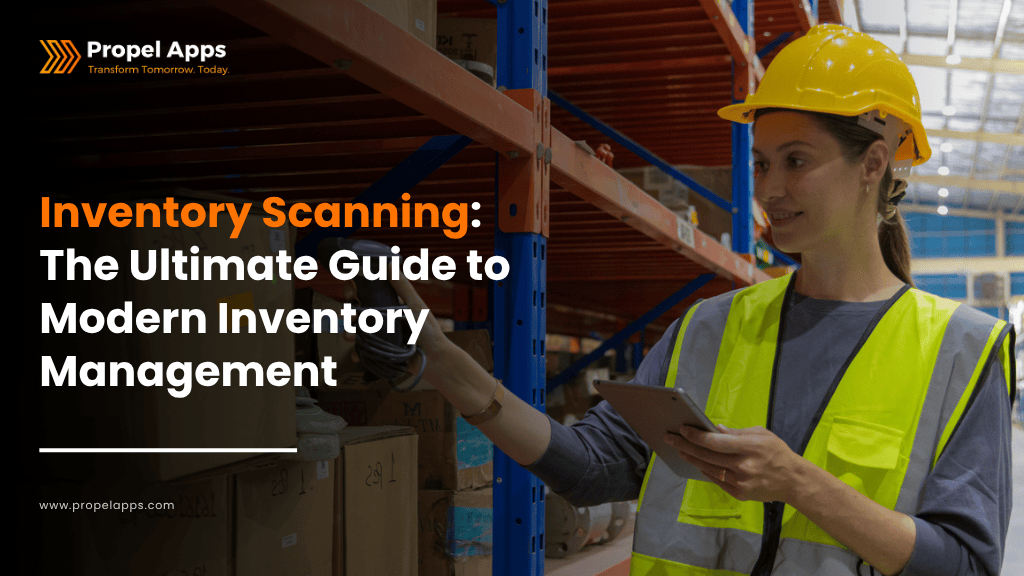
Inventory management is the process of overseeing and controlling the ordering, storage, and use of a company's inventory. A company that manages its inventory well can be highly successful in satisfying its customers' needs, while improving its profitability and brand value in the market. However, efficient inventory management is no mean task and needs meticulous planning, trained resources and above all the commitment to meet the market demands.

Manual inventory management processes are often cumbersome, time-consuming, and inefficient. Automating these processes is the optimal solution for achieving organizational goals. Consequently, inventory scanning is becoming increasingly popular, with many organizations adopting this strategy to ensure their inventory is safe, accurate, and meets consumer requirements.
This blog explores inventory scanning in detail, covering its methods, tools, benefits and challenges associated with its implementation. Lastly, it throws light on why a mobile barcode scanning solution is the right choice over a conventional inventory management system for optimizing your inventory operations, especially as a part of modern inventory tracking software.
Inventory Scanning refers to the process of using scanning technology to track, manage, and update inventory records. Any type of inventory can be tracked—whether it is food, apparel, books, industrial spare parts, components, or machinery that consumers, retailers, or wholesalers might buy. This technology typically involves barcodes or RFID tags that are attached to products or storage locations. When scanned, these tags provide real-time data on the product's status, location, and quantity. This method significantly enhances the accuracy and efficiency of inventory management processes and forms the backbone for effective inventory tracking software and inventory optimization methods.
Inventory Scanning is widely used across various industries due to its versatility and effectiveness in improving inventory management. Some of the primary industries include:
For these industries, leveraging robust inventory tracking software and proven inventory optimization methods leads to significant improvements in operational efficiency and customer satisfaction.
While Inventory Scanning and inventory barcoding are closely related, they are not the same. Inventory barcoding refers specifically to the use of barcodes to label products, whereas inventory scanning encompasses the broader process of using scanning technology to manage inventory. This can include barcodes, RFID tags, and other scanning methods.
In essence, barcoding is a subset of inventory scanning. Scanning can be done using various technologies, with barcoding being one of the most common and widely used methods—especially when integrated with modern inventory tracking software.
Counting inventory with an Inventory scanner typically involves the following steps:
As evidenced above, a combination of inventory scanning systems, inventory tracking software, and thoughtful inventory optimization methods results in highly efficient, accurate, and timely data—vastly outperforming old manual techniques. Many organizations are switching to automated scanning systems for seamless, up-to-date records and regulatory compliance.
Implementing an inventory control system that utilizes inventory scanning offers numerous benefits:
Organizations that combine inventory tracking software and inventory optimization methods gain even greater competitive advantage, scalability, and risk reduction.
Some challenges with Inventory Scanning control systems include:
Using inventory tracking software that supports easy configuration and built-in inventory optimization methods can help reduce these challenges dramatically.
To address these challenges and optimize inventory efficiency, a mobile inventory barcoding solution is the right choice. The subsequent section leads us to an interesting discussion about why a mobile barcoding solution is the most cost-effective and flexible alternative over a conventional inventory control system.
A mobile inventory barcoding solution plays a pivotal role in modern inventory scanning-based management by providing flexibility and enhancing operational efficiency. This solution typically involves a mobile device equipped with barcode scanning capabilities, enabling employees to manage inventory from anywhere within the facility.
Key advantages of a mobile inventory barcoding solution include:
By adopting mobile inventory tracking software, companies are equipped to implement advanced inventory optimization methods—helping them balance stock levels, reduce waste, and respond swiftly to demand changes.
From the above discussion, it is evident that you need a solution that is affordable, user-friendly, and meets all the benefits. In this context, explore Propel Apps' mobile inventory management solution that ticks all the above-listed benefits, while offering the best value for your investment. What's more? The solution works offline, features an intuitive, user-friendly interface, is easily customizable, and ensures your data is always secure. To learn more about our solution and how it can make a difference in the way you maintain your inventory, feel free to schedule a call with us for a free demo.
Inventory scanning and barcoding are indispensable tools for effective inventory management. By understanding the methods, tools, and best practices associated with these technologies, businesses can optimize their inventory processes, reduce costs, and improve overall efficiency. While challenges exist, the benefits of a well-implemented inventory control system—specifically a mobile inventory management solution empowered by inventory tracking software and inventory optimization methods—far outweigh the difficulties, making it a valuable investment for any industry reliant on accurate inventory management.